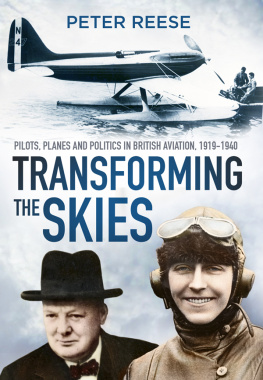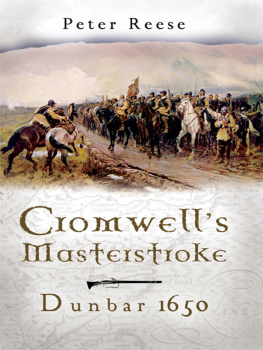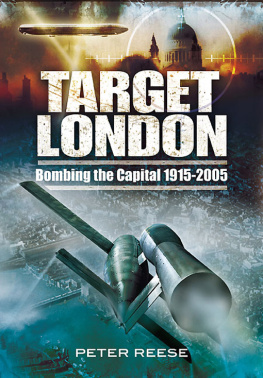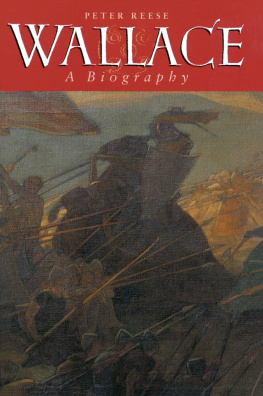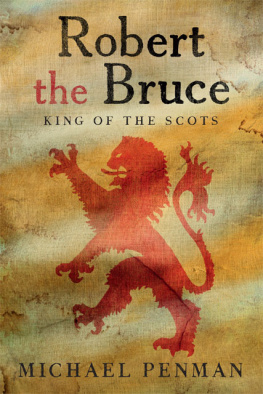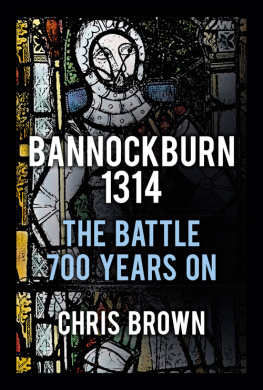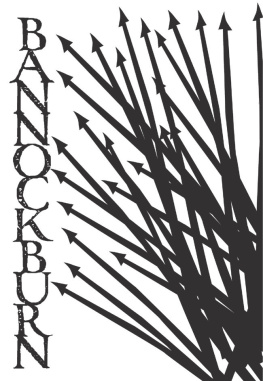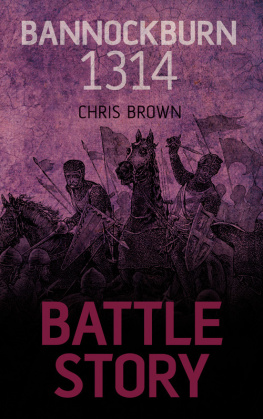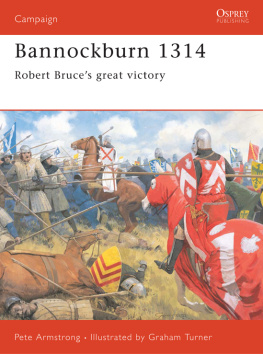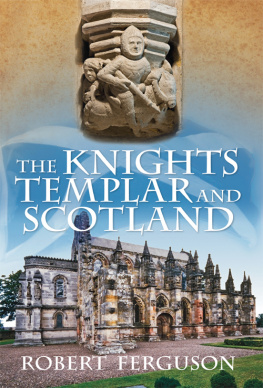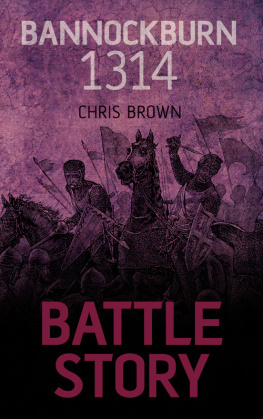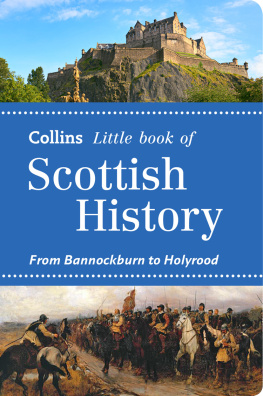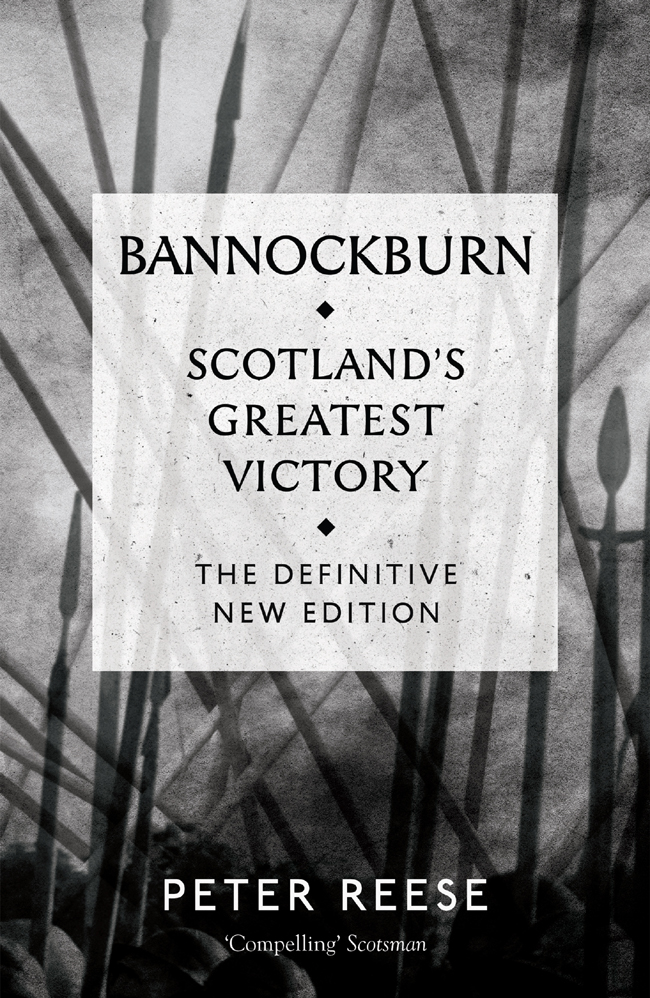Also by Peter Reese
The Scottish Commander
Wallace, A Biography
Flodden: A Scottish Tragedy
Cromwells Masterstroke: Dunbar 1650
The Life of General George Monck: For King and Cromwell
PETER REESE
BANNOCKBURN
S COTLAND S G REATEST V ICTORY

To my son, Martin
Published in Great Britain in 2000 by Canongate Books Ltd,
14 High Street, Edinburgh EH1 1TE
This new edition published in 2014
www.canongate.tv
This digital edition first published in 2014 by Canongate Books
Copyright Peter Reese 2000
Introduction to 2014 edition Peter Reese 2014
The moral right of the author has been asserted
Illustrations as credited
Maps based on Ordnance Survey Pathfinder 1:25,000 series maps by
permission of Ordnance Survey on behalf of the controller of Her
Majestys Stationery Office
Crown Copyright MC 00100012896
Maps produced by Paul Vickers and The Wheel
British Library Cataloguing-in-Publication Data
A catalogue record for this book is available on
request from the British Library
ISBN 978 1 78211 176 4
ePub ISBN 978 1 78211 468 0
CONTENTS
LIST OF MAPS AND BATTLE PLANS
INTRODUCTION TO THE 700TH
ANNIVERSARY EDITION
I needed no persuading to write this book for, whatever Bannockburns qualities as a battle and it scores highly in this regard it also marks the greatest victory ever gained by the Scots over the English. William Wallaces success at Stirling Bridge seventeen years earlier was also fought against superior forces who, with their heavy cavalry and famed bowmen, enjoyed technological superiority. At Stirling Bridge however, Wallace merely prevailed over an army led by Edward Is representative, John Warenne, Earl of Surrey, whereas at Bannockburn Robert the Bruce utterly defeated the English Army led by its monarch, Edward II. Following Wallaces victory it was predictable that the redoubtable Edward I (the so-called Hammer of the Scots) would respond by leading another army into Scotland to hunt Wallace down and complete his process of subjugation. Bruces success, however, released him from having to appeal for peace from Edward II. He had done so in 1310, attempting to gain the moral high ground along with more time to gather his military strength. His victory at Bannockburn gave him new opportunities to continue with his own diplomatic and military initiatives to free his country from English domination. In 1320, the Declaration of Arbroath justified Scotlands independence and fourteen years later, with the Treaty of Northampton, the English parliament recognised Scotland as a sovereign state and Robert Bruce as its legitimate king. Without Bannockburn he could never have succeeded, thus enabling Scotlands representatives to voluntarily enter into a process of union with England almost 400 years later.
In light of the battles pivotal importance it is surprising that relatively few accounts had been written about it until recently. It is also curious that despite the presence of a singular contemporary source on the Scottish side at least there should be such divergence about where the battle occurred a debate that continues to the present day.
When this book first appeared in 2000 it was believed to be the first dedicated analysis of the battle for some seventy-five years. Since then interest in Scottish history and the countrys most successful battle has grown, and with Bannockburns 700th Anniversary approaching more books on the subject have emerged. Despite predictable differences in interpretation, without major new archaeological discoveries or the emergence of any hitherto unknown sources about the battle, all writers like their predecessors depend largely on the four contemporary narratives used in this book. These sources recount a largely similar sequence of events. Foremost is the graphic verse account The Bruce by Archdeacon John Barbour of Aberdeen, written some sixty years after the battle. It is in the style of other fourteenth-century romances rather than a blowby-blow account of events, but Barbour did have access to contemporary chronicles and talked with the descendants of men who fought in the battle. While an undoubted work of art, the general accuracy of The Bruce has also been acknowledged by several subsequent writers.
Although far shorter, there are contrasting commentaries representing the English side. There is the Scalacronica the so-called ladder chronicle due to its authors desire to survey events from a detached position written by Sir Thomas Grey, the younger, whose father was taken prisoner at Bannockburn. His soldiers account was completed in 13551356 and drew freely on his fathers experiences. The second, Vita Edwardi Secundi (Life of Edward II) is not strictly a chronicle but a journal about the Kings reign, probably written in 1326 by the well-connected John Walwayn, agent to the Earl of Hereford. A fragment of the Chronicle of Lanercost constitutes the third account and was written by an Augustinian monk or a succession of monks from the Priory at Lanercost. The Priory was the target of repeated Scottish raids and unsurprisingly the account shows strong English prejudices.
Invaluable as such sources are for studying the battle, their failure to give a clear indication about where the main engagement occurred has led to remarkable consequences. Initially it was thought to be in the locality of Bruces Borestone (in which he placed his standard) where the Rotunda Memorial, Pilkington Jacksons equestrian statue of Robert the Bruce, and the Bannockburn Heritage Centre stand today. However, in 1913 a book by William MacKay MacKenzie conclusively disproved this site as the location of the battle, although MacKenzies suggested alternative to the east, close to the River Forth, has also been conclusively rejected. Contemporary writers have further limited the site but still differ over whether the battle occurred on Carse Land near Balquhiderock or within corn land nearby, with some still unwilling to commit themselves either way. Both sites however, lie over one-and-a-quarter miles from the Heritage Centre.
While researching this book and walking the battlefield to help me determine the location of the main clash of arms, I resolved to examine the conflict by assessing the opposing leaders military experience and capabilities (together with those of their subordinate commanders). I also considered the characteristics of both armies including their weaponry, favoured tactics and their reported use of the ground. As a result, I concluded that the most likely location is on Carse land enclosed by the two water courses, the Bannockburn and the Pelstream Burn adjoining the dry field of Balquhiderock. However on 24 June 2014 when the Battles 700th anniversary celebrations take place they are to be held on the Borestone site which has been newly landscaped. The Rotunda Memorial and equestrian statue of Robert the Bruce have been refurbished and a new visitor centre created. Here visitors will be able to experience a virtual recreation of the two-day battle.
While this undoubtedly represents a massive advance over previous facilities, fundamental questions remain about the actual site of the battle. To date no archaeological survey has been commissioned for the most favoured area (and therefore no mass graves have been discovered) and more serious still no preservation methods have been put in place to protect this site. Unlike the Heritage Centre which enjoys the protection of the National Trust, the most likely true site of the battle remains vulnerable to further urban development, if not eventual obliteration. To help avoid such a tragedy I believe that a ban should be placed on further building and that steps be undertaken to purchase all available ground for the Scottish nation.


